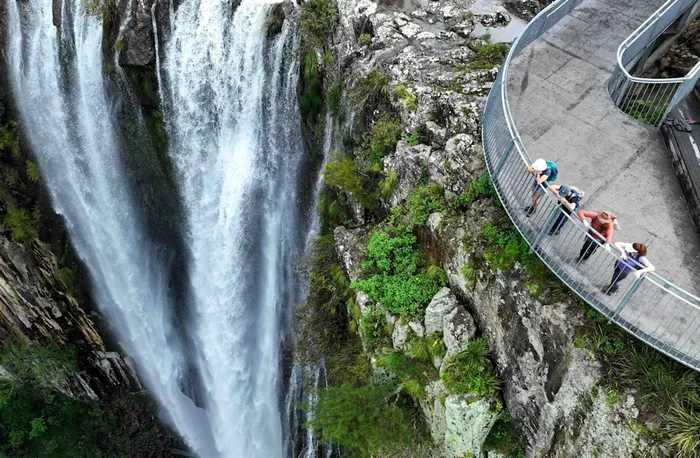Australia has unveiled a breathtaking new hiking trail in northern New South Wales: the Gidjuum Gulganyi Walk, a four-day, 42-kilometre guided experience that traces ancient Aboriginal songlines and trade routes through some of the last remaining stretches of Gondwanan rainforest.
The trail’s name, meaning “Old People’s Track,” was developed in consultation with the Widjabul Wia-bal native title holders of the Bundjalung Nation and the Tweed Byron Local Aboriginal Land Council. The walk was launched in April as part of a broader initiative by the NSW National Parks and Wildlife Service, which is rolling out 13 multi-day hikes, three of which are still in development. Starting mid-June, the Gidjuum Gulganyi Walk also features the Northern Rivers region’s first-ever glamping option, operated by Vision Walks, one of only two companies licensed to guide hikers on this path.
Despite the modern additions, the trail itself is deeply rooted in the past. It winds through diverse ecosystems—from warm temperate and subtropical rainforests to sclerophyll forests—while skirting the southern rim of the ancient Tweed Caldera. This caldera was formed 23 million years ago when the Wollumbin volcano (formerly Mount Warning) last erupted.
The walk begins at a serene creek beneath Unicorn Falls, where Vision Walks guide and ecologist Skye Weatherstone introduces hikers to a traditional Indigenous protection ritual. By touching the water, she symbolically seeks permission and protection from ancestral spirits, honoring the spiritual significance of the land.
Over four days, the Gidjuum Gulganyi offers a dynamic landscape: towering strangler figs, palm forests, bloodwoods, blackbutts, and stringybarks, as well as wetland crossings on rustic log bridges. The ever-changing terrain shifts from rocky trails and tree roots to muddy patches and mossy undergrowth.
A major draw of this hike is its pack-free experience. Hikers carry only daypacks, while campsites are prepared in advance. Each site includes spacious tents with camp beds, sleeping bags, pillows, a shower tent, a well-stocked camp kitchen, and a sheltered dining area. Meals, snacks, and drinks are locally sourced—from Brookfarm muesli and Stone & Wood beers to Nimbin Valley cheeses and Love Byron Bay chocolates—catered by the Bloody Good Food Co.
Mobile signal and internet are non-existent, adding to the sense of retreat and immersion. Over the course of the trek, hikers encounter very few others on the trail, enhancing the feeling of solitude and connection with nature.
Each day involves five to six hours of hiking, except for the second day, which stretches into an 18-kilometre journey climbing to 800 meters above sea level along the caldera rim. The trail can be challenging—especially with persistent rain, mud, and leeches—but it rewards hikers with misty glimpses of Wollumbin and the coastline from scenic lookouts.
A unique feature of the experience is the silent walk each morning, encouraging hikers to attune to the sounds of birds and subtle details like tiny mushrooms on mossy logs. Throughout the journey, Skye Weatherstone shares insights into how the Minjungbal and Widjabul Wia-bal peoples traditionally used the forest as a source of food, medicine, and shelter. Future walks will also include direct engagement with a Bundjalung guide who will offer cultural interpretations of the path.
On the third day, hikers are treated to sweeping views of Wanganui Gorge, where three powerful waterfalls cascade in the distance. Campsites here are nestled among tall eucalyptus trees, offering panoramic vistas right from the dining area.
The trail culminates at Minyon Falls, a well-known local landmark. While most visitors view the falls from above, Vision Walks extends the hike with an additional six-kilometre route down to the base. This final section is the most strenuous, involving a creek crossing and a boulder scramble. However, the payoff is immense—standing at the foot of the roaring falls offers a powerful, immersive connection to the landscape.
Reflecting on the hike, guide Skye Weatherstone notes how the trail not only revives ancient pathways but also reconnects people to Country. She expresses hope that this renewed interaction fosters appreciation and stewardship for the natural world.
The Gidjuum Gulganyi Walk stands out not just for its scenic and ecological variety, but for the depth of cultural reverence it brings to the hiking experience—making it one of Australia’s most meaningful and enriching treks to date.
Related Topics
- Extreme Heat Turns Deadly: Grand Canyon Officials Urge Hikers to Stay Away This Week
- Heartfelt Community Event Raises $65K for Red Deer Hospice Care
- Cooler-Weather Hikes Just Steps Away From Downtown Idyllwild Offer Refreshing Outdoor Escape

